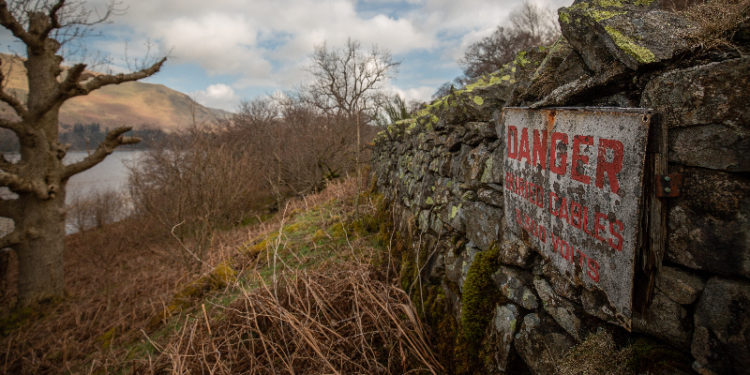Why a Site Might be Abandoned P3

(Author’s note: I’m picking up where I left off numerically)
One of the classic D&D tropes is a party entering a dungeon. Such places are either abandoned, in the middle of nowhere, or, sometimes, under a bustling city, but forgotten. Sometimes, these sites don’t need many repairs to make them usable. If this is is the case, often other things have taken up residence. But that begs the question, why were they abandoned in the first place? This article will answer that question. Read on:
21 Technology improved.
The original reason the structure was built becomes obsolete. For instance, previous technology may have required an entire coal operation to produce heat and electricity and something cleaner came along such as natural gas or electricity. “Technology” isn’t limited to technology per se either. Remember Clarke’s Third Law, Reversed which states “Sufficiently analyzed magic is indistinguishable from technology.” If a newly analyzed form of magic comes to the forefront that is more potent than its predecessor(s), it may negate the need for various structures, thus causing their abandonment.
22 Instant Burial
The location was buried by something, and either the occupants could have been saved, or killed instantly or shortly thereafter from the experience. This type of a thing is caused by geological activity, freakish weather patterns, or rapidly changing global conditions.
D6 types of burial
- Ash. In the city of Pompeii, the entire city was buried in ash, which killed the residents instantly. There have been plaster casts made out of the victims.
- Lava .If a city is on an active volcanic island lava may bury a community. If it happens repeatedly, the people living there may have decided to evacuate. Conversely, the eruption may have happened so quickly that there wasn’t time to evacuate.
- Rockslides are the most dangerous form of landslide to both structures and life because they are incredibly fast. Oftentimes a single stone can cause a cascading release of tons of rock to come crashing down. Similar to a rockslide is a mudslide. Such disasters are caused by erosion, deforestation, weather, or earthquake in real life. Though in a fantasy setting, they might be caused by monsters tunneling beneath the surface or wandering earth elementals. They can, however, be stopped, if known about in advance through the use of wire meshing, retaining walls, soil nailing, and rock bolting. An ingenious mage might even permanently cast “wall of force” to stop such an event, while simultaneously using such to detect intruders to his property.
- Avalanches occur when a mass of snow lying upon a weaker layer of snow fractures and slides down a steep slope. There are four types of avalanches
- A slab avalanche forms in snow that has been deposited, or redeposited by wind. They look like a snow block cut out from its surroundings by fractures. A “slab” is a cohesive plate of snow that slides as a unit on the snow underneath. Picture tipping a table up on edge that has a magazine on it. What happens? The magazine slides off the table. Now picture you’re standing in the middle of the magazine. These avalanches are the most deadly.
- Wet snow avalanches move slowly due to the friction between the sliding surface of the track and the water saturated flow. Despite the low speed, wet snow avalanches are capable of generating powerful destructive forces, due to the large mass and density. Wet snow avalanches are capable of ploughing through soft snow, tearing up boulders, earth, trees, and other vegetation; leaving exposed and often scored ground in their wake. At temperate latitudes wet snow avalanches are frequently associated with climatic avalanche cycles at the end of the winter season, when there is significant daytime warming.
- powder snow avalanches consist of a powder cloud, which overlies a dense avalanche. They can form from any type of snow, but usually occur with fresh dry powdery snow. Reaching 190+ mph, and they can weigh 10,000,000 metric tons. Their flows can travel long distances along flat valley bottoms and even uphill for short distances.
- Slush avalanches usually occur in very northern latitudes on very gentle slopes (typically 5-20 degrees). A slush avalanche ordinarily occurs in impermeable permafrost soil, allowing water to pool up. It occurs during rapid saturation of a thin, weak snowpack. As this happens, it catastrophically loses its strength and the resulting slush often runs long distances on very gentle terrain.
- Water. If a dam, levy, or other manmade or natural barrier holding back untold gallons of water breaks, that water has to go somewhere. All that water rushing towards people and structures that were there would instantly get swept away in the current. Conversely, a tsunami could be the cause of the water that flooded a place. Weather events such as hurricanes, waterspouts, or simply an excess of rain could cause a place to become flooded.
- Fire. Even though one doesn’t necessarily think of getting buried by fire, from a certain standpoint, it’s possible. Wildfires can sweep through an area, and the destruction it causes can be a real danger to inhabitants living in an area. Fire can weaken structures as well as the surrounding wilderness. If the weather conditions are just right, “fire tornadoes” form.
23 Out of spite
During Nazi Germany, instead of letting the Allies get ahold of their ill-gotten loot, some high-ranking officers dump their find in a lake. Maybe in your game, an organization abandoned or destroyed a site so as not to let it fall into enemy hands. If you’ve watched 80s cartoons, destroying their base is a classic trope of the BBEG.
24 Divine Decree
In the bible, God evicts Adam and Eve from the Garden of Eden because of their sin. Maybe someone has done something that offended or endangered the gods, and they have decreed that no one is to enter the area. Perhaps the PCs have done something that caught the gods’ attention. As punishment, they have been shunted to this area to keep them out of trouble. Conversely, the gods (or other forces) could have sent the PCs there to keep them out of the way. While the PCs are there, not able to interfere, other things can happen.
Similarly, something the PCs do could attract the attention of Ravenloft’s mists. And instead of grabbing a single PC, it traps all of them to teach a lesson. The location could be a thematically appropriate abandoned location that they must find their way out of.
25 Abandoned ship
A ship might be abandoned for a variety of reasons. There could have been a mutiny, forcing most of the crew to abandon the ship. Those that remained, died. Death on long sea voyages are common occurrences. Scurvy, lack of fresh water, severe injury or disease, and fire all contributed to deaths. If the entire crew was on the deck of the ship during a storm, they could have been swept overboard.
Then there’s the possibility of sinking. It may have been sunk because it ran aground, sank in a battle, ran into an iceberg, was capsized by stormy weather, or scuttled (deliberately sank). Unless those who were onboard the ship could breathe underwater indefinitely, they would have to “abandon ship!” The reason why it sank might be up to the PCs to discover. Ships at the bottom of bodies of water also often have sunken treasure with them.
D6 types of sunken treasure
- Coins (Gold, silver, etc.)
- Jewelry (rings, necklaces, broaches)
- Valuable Artwork not susceptible to water damage: sculptures, beautiful plates, etc.
- Lost Technology (Antikythera mechanism)
- Historical documents sealed in a watertight container
- Proof of why the ship sank (scientific/ discovery treasure)
D10 Abandoned Ship Dangers
- Getting lost. Because most of the characters are unfamiliar with the ship, they may get turned around. It’s especially dangerous to get lost in a water filled ship. Both water breathing spells and SCUBA gear isn’t designed to allow the people using them to be underwater indefinitely.
- Structural problems. On an old ship, the decking isn’t stable or the mast could require a blow in just the right spot to break. Conversely, perhaps the reason the ship sank was because of structural problems and the characters poking around in the ship causes them to get worse.
- Falling / floating objects. Not everything on a ship is bolted or strapped down. If the characters are in an abandoned ship that’s hit rough waters, some unsecured objects could fall. This is even possible if the characters are underwater. Conversely, if the ship is underwater, unsecured buoyant items can cause problems. They can float up blocking passages, and interfere with underwater attacks.
- Rats or other pests. Both ancient and modern ships are susceptible to infestations. A ship that’s been adrift for years might have an omnipresent swarm of rats, filling up every nook and cranny. Even spells that target vermin specifically may not be enough to hedge them out, particularly if they’re dropping in from above. A similar scenario may exist with termites, snakes, or seagulls that hitched a ride on a vessel.
- Ghosts/ Zombies and/or Skeletons. Ghost ships are called thus for a reason. They are haunted, often appearing out of dense fog. Even if there are no ghosts per se to deal with, there still may be zombies or skeletons to deal with. These might be those who were scared to “cross over to the other side.” They might be angry that their lives got cut short. Whatever the case, the undead in such circumstances are never happy to see the living.
- Bad air. Just because a ship hasn’t sunk yet and isn’t infested with rats or undead, doesn’t necessarily mean that it’s safe. Just like the sealed Pharaoh’s tombs, ships can get bad air. It can be from gas buildup, nuclear radiation, or some other mundane or magical power source.
- If the disease that killed off the crew is particularly virulent, it may still be a hazard. Such hazards might be contact, waterborne, or in the air.
- Out of time. Maybe the ship is displaced in time and only appears for so many hours every set number of years. If this is the case, should the PCs board the vessel, they may be “in limbo” until the ship reappears.
- Out of phase. The ship is not in the same reality as the characters. With such a scenario, parts of the ship could phase in and out, leaving the characters stuck in the floors or bulkheads as in the Philadelphia Experiment
- Active weapons. The ship is empty, but the weapons are still active. Maybe they were animated objects, computer-controlled systems, or “armed” warheads. These could give the PCs trouble if the characters activated them somehow.
Conclusion
There are a variety of reasons why a site might be abandoned. The list presented here was just a few.
When preparing an abandoned site, ask yourself the following questions:
- What was this site used for?
- Why was it abandoned? What is its story?
- Who was there before?
- Has something else moved in? If so, what?
- What did they leave behind?
By using abandoned sites as a springboard to drive the plot, you can make better use of your game’s locations. Look out for part 4 of this series soon.



